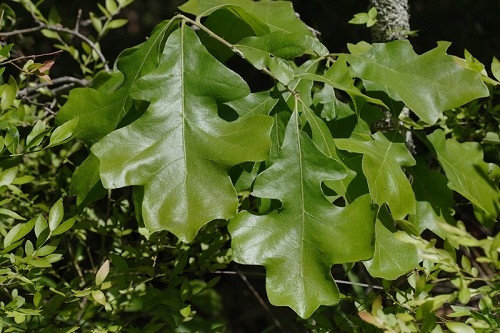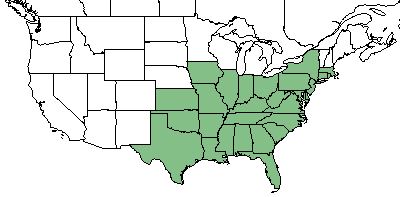Difference between revisions of "Quercus stellata"
(→Cultural use) |
|||
| Line 53: | Line 53: | ||
==Cultural use== | ==Cultural use== | ||
| + | Acorns were an important staple for Native Americans in making flour for breads. The meat could also be edible once the tannins were leached from the acorns.<ref> Fernald, et al. 1958. Edible Plants of Eastern North America. Harper and Row Publishers, New York.</ref> | ||
| + | |||
| + | The fruit of this particular species has a sweet juice that can be consumed.<ref> Fernald, et al. 1958. Edible Plants of Eastern North America. Harper and Row Publishers, New York.</ref> | ||
| + | |||
==Photo Gallery== | ==Photo Gallery== | ||
<gallery widths=180px> | <gallery widths=180px> | ||
</gallery> | </gallery> | ||
==References and notes== | ==References and notes== | ||
Revision as of 13:35, 10 June 2021
Common name: post oak [1]
| Quercus stellata | |
|---|---|

| |
| Photo by John Gwaltney hosted at Southeastern Flora.com | |
| Scientific classification | |
| Kingdom: | Plantae |
| Division: | Magnoliophyta - Flowering plants |
| Class: | Magnoliopsida - Dicots |
| Order: | Fagales |
| Family: | Fagaceae |
| Genus: | Quercus |
| Species: | Q. stellata |
| Binomial name | |
| Quercus stellata Wangenheim | |

| |
| Natural range of Quercus stellata from USDA NRCS Plants Database. | |
Contents
Taxonomic Notes
Synonyms: Q. villosa Walter
Varieties: Q. stellata var. stellata
Description
Q. stellata is a perennial tree of the Fagaceae family native to North America.[2]
Distribution
Q. stellata is found in the southeastern corner of the United States from Texas to Massachusetts.[2]
Ecology
Habitat
Q. stellata proliferates in uland forests and woodlands, especially in clay or rocky soils and in communities at least formerly exposed to fire.[1] Specimens have been taken from mesic woodland, pine-oak stands, hardwood forests, second growth woodland with sandy soil, open pine oak woodland, and old growth pineland.[3] Q. stellata responds negatively to soil disturbance by roller chopping in Northwest Florida sandhills.[4]
Quercus stellata is frequent and abundant in the Clayhill Longleaf Woodlands community type as described in Carr et al. (2010).[5]
Phenology
Q. stellata has been observed to flower March through May and in November.[6] Native, perennial tree to 75.0 feet. Bark usually gray to gray-brown, relatively thick, irregularly fissured with narrow or broad scaly ridges; leaves deciduous, alternate, simple, stellate-hairy on lower surface, usually 5-7 lobed (not bristle tipped), the upper 3 lobes usually being the largest, usually having somewhat of a crosslike appearance; plants monoecious; inflorescences are catkins; fruit is a 1-seeded nut called an acorn, 1-2 clustered, cup enclosing 33-50% of the nut, maturing the first year in the fall.[7]
Fire ecology
Q. stellata is not fire resistant and has medium fire tolerance.[2]
Use by animals
Q. stellata has low palatability for grazing and browsing animals.[2]
Conservation, cultivation, and restoration
Q. stellata is listed as a special concern species by the Rhode Island Department of Environmental Management.[2]
Cultural use
Acorns were an important staple for Native Americans in making flour for breads. The meat could also be edible once the tannins were leached from the acorns.[8]
The fruit of this particular species has a sweet juice that can be consumed.[9]
Photo Gallery
References and notes
- ↑ 1.0 1.1 Weakley, A. S. (2015). Flora of the Southern and Mid-Atlantic States. Chapel Hill, NC, University of North Carolina Herbarium.
- ↑ 2.0 2.1 2.2 2.3 2.4 USDA Plant Database https://plants.usda.gov/core/profile?symbol=QUST
- ↑ URL: http://herbarium.bio.fsu.edu. Last accessed: June 2018. Collectors: Loran C. Anderson, Jack P. Davis, R.K. Godfrey, Gary Knight, Richard Mitchell, H. Kurz, Kurt Blum, Celeste Baylor, Chris Cooksey, R.F. Doren, R. Komarek, K.M. Meyer, A. Townsmith. States and counties: Florida (Leon, Nassau, Okaloosa, Escambia, Wakulla, Jackson, Gadsden, Liberty, Marion, Washington) Georgia (Thomas, Grady)
- ↑ Hebb, E.A. (1971). Site Preparation Decreases Game Food Plants in Florida Sandhills. The Journal of Wildlife Management 35(1):155-162.
- ↑ Carr, S.C., K.M. Robertson, and R.K. Peet. 2010. A vegetation classification of fire-dependent pinelands of Florida. Castanea 75:153-189.
- ↑ Nelson, G. PanFlora: Plant data for the eastern United States with emphasis on the Southeastern Coastal Plains, Florida, and the Florida Panhandle. www.gilnelson.com/PanFlora/ Accessed: 29 MAY 2018
- ↑ Gee, K. L., et al. (1994). White-tailed deer: their foods and management in the cross timbers. Ardmore, OK, Samuel Roberts Noble Foundation.
- ↑ Fernald, et al. 1958. Edible Plants of Eastern North America. Harper and Row Publishers, New York.
- ↑ Fernald, et al. 1958. Edible Plants of Eastern North America. Harper and Row Publishers, New York.